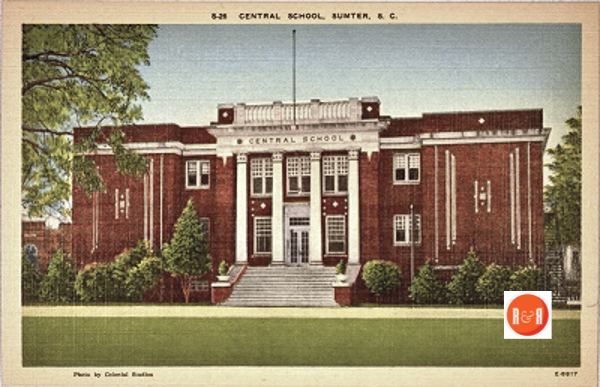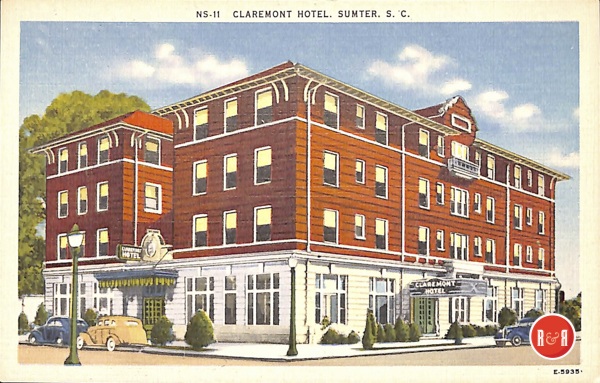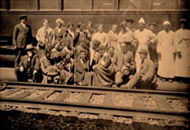SUMTER COUNTY, SOUTH CAROLINA

Central High School – Image courtesy of the Wingard Postcard Collection, 2013
“The soil here is very porous and therefore readily absorbs the rainfall. These are some of the causes of the city’s healthiness. The atmosphere is balmy and dry and is thoroughly impregnated by the ozone from the immense pine forests which stretch away for miles in every direction. This feature of the climate explains the rareness of pulmonary diseases here and affords an asylum for all who suffer from the rigors of a
severer climate. But the reader must not think that these pine lands are unbroken fastnesses. A large portion of the soil has for many years been literally “fields of abundance.” There is a double reason for this: the fertility of the land and the intelligence of the planters. Strangers always remark upon the degree of culture attained by the majority of the people in this county. There is as little—not to say less— illiteracy here as there is in any county in the South. Throughout the county there are comfortable farm houses, and in many fields the most improved labor-saving machines are at work. Cotton is the staple crop of commerce, but large crops of com, hay, oats, wheat, peas, and sorghum are grown in all sections of the county. It is estimated that there is sold annually in the city of Sumter, for local consumption, several thousand dollars’ worth of county-raised hay. But it is its cotton crop in which the county takes so much pride. At least 50,000 bales are grown here annually, and the quality is of the finest. Twenty-three thousand bales are sold in this city, thus giving it from one source alone a trade of over a million dollars. There are two other large industries which contribute many thousands to the city’s business—the distillation of turpentine and the manufacture of lumber. Throughout every portion of the county turpentine ”farms” are scattered, and the song of the saw mills sounds along all the timber belts.

Postcard of the Sumter, S.C. Claremont Hotel. Courtesy of the AFLLC Collection – 2017
There are rare facilities for marketing this great wealth, but they are constantly being improved. Many years before the war the Wilmington, Columbia, and Augusta Railroad was completed, connecting Sumter with Columbia and the North. The Northeastern Road gave a line via Florence to Charleston. As this placed the metropolis one hundred and forty miles away, the Central Road was built about eight years ago, affording this city a direct line, ninety miles long, to the “City by the Sea.” Standing on the high road to great marts of the West and North and being nearer to Charleston than any inland town its size, Sumter occupies an enviable position.
But being a progressive city she is by no means satisfied with her facilities for transportation. Only recently she donated land to the Eutawville Railroad for depots and workshops. This road gives another line to Charleston and will connect at Cheraw with die Robinson system of railways, giving two lines to the North which will compete with each other. The Atlantic Coast Line has begun an extension to Augusta, and this will be completed as soon as the Coast Line’s contract with the Charlotte, Columbia, and Augusta Road expires. This will give two lines to Florida and the Southwest. In the efforts for the development of this dty the plan for securing the construction of a road to Camden to connect with the Three C’s Road is second to none. This would give Sumter a competing line to the West, which is needed now and will be needed more in the future. For everything from the West (and what vast purchases we make in that section!) this city and all the other towns of North and South Carolina are dependent upon the roads of the Richmond Terminal system. If Sumter could get the Charleston, Cincinnati, and Chicago Railroad to connect here with the Coast Line, she would have a short line to the coal and iron fields of Tennessee and the grain and meat markets of the West.
This city will doubtless be a great manufacturing center in the near future, and then the matter of cheap fuel will be a momentous one. This is an age of competition and small profits, and no manufacturing enterprise can succeed unless the cost of production is reduced to a minimum. Eighteen months ago the general manager of the Three C’s proposed to build his road to Sumter, provided $80,000 was subscribed to it by this county. Only a few months ago President Coxe informed the writer that the offer was still open. It is to be hoped that the people here will avail themselves of it.
Two years ago Sumter was made a city, and the corporate limits were extended a quarter of a mile. After this was done there was a population of 4,000, which has since grown to at least 4,500. The streets were improved, several thousand dollars were expended in improving the drainage, and soon the place was a city in appearance as well as in name. In 1882 the total value of real and personal property was $675,000. Now it is, including the manufacturing enterprises which have been built since 1882, $1,580,000. A very large part of this increase has been caused by the rise in real estate values, which has recently been phenomenal. Only a few weeks ago a lot 100 feet deep with a 30-foot frontage on Main Street sold for three thousand dollars! Every sort of property has been improved, and the building fever which set in several years ago has not abated a whit. There are several long streets on which the larger number of the residences have been built within the past eight years. In five years the amount invested in mercantile enterprises has been increased at least 30 percent.
The Yorkville Enquirer reported on May 5, 1870 – “The Sumter Hotel was found to be on fire on April 21st. It is an old wooden building in the business part of town and everyone feared a great fire. However, the fire engine arrived and was able to quickly extinguish the fire.”
The Rock Hill Herald reported on Oct. 13, 1881 – “Col. James Winn President of the Belmont Cotton Factory in Sumter reports the building will be completed by the first of Dec., and will cost $100,000.”
The Yorkville Enquirer on July 24, 1884 reported, “The Sumter Cotton Mill has shut down and the property is for sale.”
Five years ago there was nothing here in the line of factories save several shops for the repairing of vehicles and a few grist mills. In 1885 the Sumter Cotton Mills began work with 1,900 spindles. This plant cost about $70,000 and was built with local capital. Eight hundred spindles were added three years ago, when the company was reorganized. These mills run twenty-one hours a day and produce 21,000 pounds of yam per week. One hundred and twenty-five operatives are employed. The officers of the company are: D. James Winn, president and general manager; A. Moses, secretary and treasurer; directors, R.M. Wallace, E.W. Moise, C.T. Mason, Jr., D. James Winn, A. Moses, E.H. Holman, and M.G. Ryttenberg.
Last summer Lukens and Reifanyder established here the most extensive planning mills and dry kilns in the State. The plant cost over $15,000 and is… in connection with the large lumber mills at Harvin’s, which are owned by the same firm. But it takes the output of several large mills to keep the planning mills and kilns running on full time. Mr. J.T. Laughery is the manager of this enterprise and will take pleasure in giving lumbermen any information which they may desire about Sumter’s advantages as a point for purchasing stock.
Only twelve miles to the west are the hard wood forests of the Wateree, where millions of dollars’ worth of oak, walnut, boxwood, poplar, and cypress await the enterprising capitalist. On the whole, this is probably the most advantageous point in the State for the establishment of a large sash, door, and blind factory or furniture works. Mr. J.A. McClure, who has managed extensive lumber interests here for several years is of this opinion. He has travelled over the greater part of the South and is therefore a capable judge of a place’s merits. The Curtis Carriage Company has been in business here for many years, and its trade has grown with the city’s progress. R.W. Bradham, a year or two ago, began the manufacture of vehicles and has found it necessary to increase his plant.
As the city has grown, the opportunities which it offered over other places were increased, and even those who sold their cotton at other places came here to spend their money. The large houses here have as expert buyers in all lines as there are in the State, and these visit the great markets North and West every season. Such enterprise could result but one way. There are half a dozen houses here which carry as fine stocks as are found in many cities twice as large as this one. A board of trade has recently been organized and has already done much in the interest of the city’s business. The officers are A. Moses, president; R.M. Wallace, vice president; and L.S. Carson, secretary and treasurer. In 1887 the Simonds National Bank began business with a capital of $50,000. Last January this was increased to $75,000. Ever since it has been established this bank has paid 4 per cent semi-annual dividends and has now on hand surplus and undivided profits amounting to $10,000. The average amount of deposits is $80,000.
The Yorkville Enquirer reported on Nov. 16, 1887 – “The comptroller of the currency has authorized Simond’s National Bank of Sumter to begin business with a capital stock of $50,000. Mr. Simond is Pres., and Col. R.M. Wallace is V.P.”
The officers are: Andrew Simonds, president; R.M. Wallace, vice president; W. Alston Pringle, Jr., cashier; directors, Andrew Simonds and E.E. Salinas of Charleston; R.M. Wallace, A.J. China, R.D. Lee, Horace Harby, and John Reid of Sumter.
The Bank of Sumter began business last February with a paid in capital of $50,000. It has not yet paid a dividend, but its undivided profits already amount to $4,000. Its deposits average $50,000. The officers are: W.F.B. Haynesworth, president; Marion Moise, vice president; A. White, Jr., cashier; directors, A. Moses, W.F.B. Haynesworth, Marion Moise, T.B. Johnston, A.S. Brown, and C.E. Stubbs. The Sumter Building and Loan Association began business in June 1885. It has loaned to date, in round numbers, $85,000, at an accrued profit of 70 per cent. This institution has been of incalculable benefit in the improvement of the city and still continues its usefulness actively. The officers are: A.J. China, president; A. Moses, vice president; H. Frank Wilson, secretary and treasurer; directors, M. Moise, W.M. Graham, A.J. China, A. Moses, H. Harby, Neil O’Donnell, John S. Hughson, R.D. Lee, and R.M. Wallace.
The People’s Building and Loan Association was organized last February under the following management: R.D. Lee, president; R.O. Purdy, vice president; Thomas E. Richardson, secretary and treasurer; directors, M. Moise, J.D. Graham, John Reid, E.B. Lowry, A.B. Stuckey, R.D. Lee, and R.G. Purdy.” Also see Sumter County’s R&R page dedicated to the images of early Sumter County schools.
Reprinted from South Carolina in the 1880s: A Gazetteer by J.H. Moore, Sandlapper Publishing Company – 1989
Stay Connected
Explore history, houses, and stories across S.C. Your membership provides you with updates on regional topics, information on historic research, preservation, and monthly feature articles. But remember R&R wants to hear from you and assist in preserving your own family genealogy and memorabilia.
Visit the Southern Queries – Forum to receive assistance in answering questions, discuss genealogy, and enjoy exploring preservation topics with other members. Also listed are several history and genealogical researchers for hire.
User comments welcome — post at the bottom of this page.
.


Share Your Comments & Feedback: